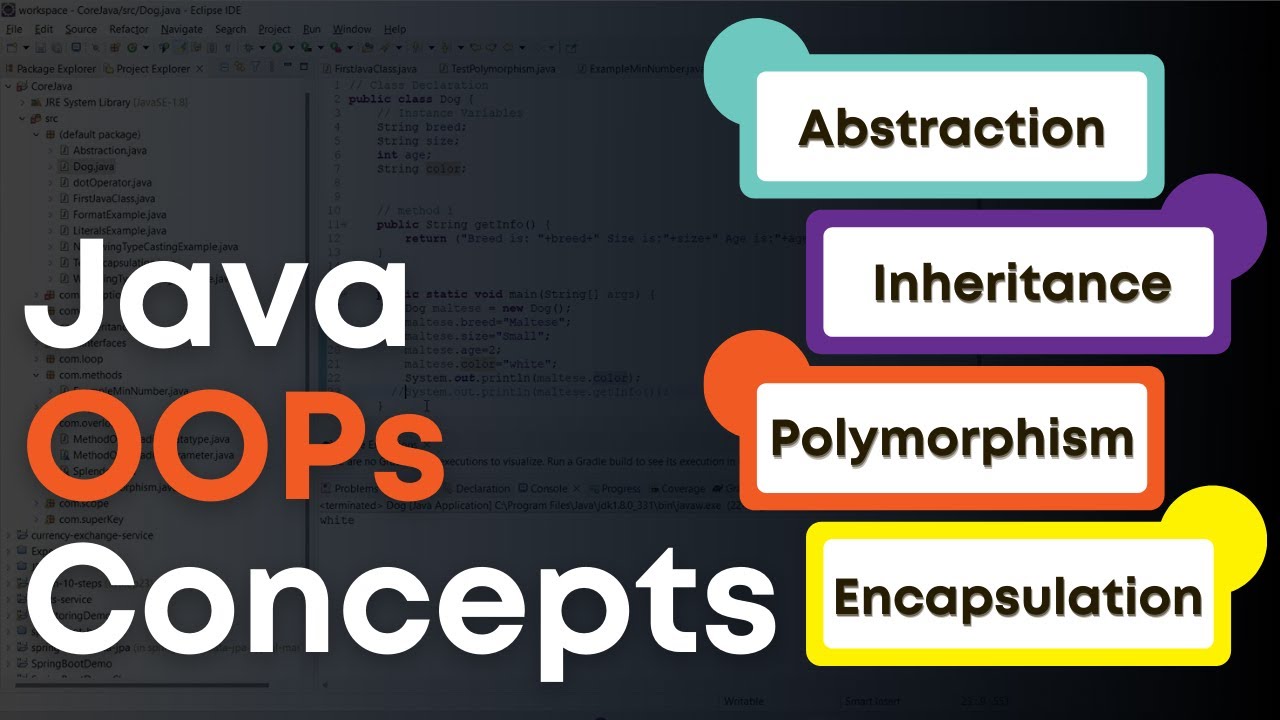Object Oriented Programming Concepts are very important. Without having an idea about OOPS concepts, you will not be able to design systems in the object-oriented programming model. It simplifies software development and maintenance. Let’s Learn OOPS concepts in Java with real time examples and source code examples.
Object-Oriented Programming (OOP) Concepts
The core OOPs concepts:
- Object
- Class
- Abstraction
- Encapsulation
- Inheritance
- Polymorphism
Let’s discuss above each OOPS concepts with a real-world example.
1. Object
The Object is the real-time entity having some state and behavior. In Java, Object is an instance of the class having the instance variables like the state of the object and the methods as the behavior of the object. The object of a class can be created by using the new keyword in Java Programming language.
A class is a template or blueprint from which objects are created. So, an object is the instance(result) of a class.
I found various Object Definitions:
1. An object is a real-world entity.
2. An object is a runtime entity.
3. The object is an entity which has state and behavior.
4. The object is an instance of a class.
Real-world examples
- Dogs have state (name, color, breed, hungry) and behavior (barking, fetching, wagging tail). Chair, Bike, Marker, Pen, Table, Car, Book, Apple, Bag etc. It can be physical or logical (tangible and intangible).

- Bicycles also have state (current gear, current pedal cadence, current speed) and behavior (changing gear, changing pedal cadence, applying brakes).
How to Declare, Create and Initialize an Object in Java
A class is a blueprint for Object, you can create an object from a class. Let’s take Student class and try to create Java object for it.
Let’s create a simple Student class which has name and college fields. Let’s write a program to create declare, create and initialize a Student object in Java.
package net.javaguides.corejava.oops;
public class Student {
private String name;
private String college;
public Student(String name, String college) {
super();
this.name = name;
this.college = college;
}
public String getName() {
return name;
}
public void setName(String name) {
this.name = name;
}
public String getCollege() {
return college;
}
public void setCollege(String college) {
this.college = college;
}
public static void main(String[] args) {
Student student = new Student("Ramesh", "BVB");
Student student2 = new Student("Prakash", "GEC");
Student student3 = new Student("Pramod", "IIT");
}
}From the above program, the Student objects are:
Student student = new Student("Ramesh", "BVB");
Student student2 = new Student("Prakash", "GEC");
Student student3 = new Student("Pramod", "IIT");Each of these statements has three parts (discussed in detail below):
Declaration: The code Student student; declarations that associate a variable name with an object type.
Instantiation: The new keyword is a Java operator that creates the object.
Initialization: The new operator is followed by a call to a constructor, which initializes the new object.
Declaring a Variable to Refer to an Object
General syntax:
type name;This notifies the compiler that you will use a name to refer to data whose type is a type. With a primitive variable, this declaration also reserves the proper amount of memory for the variable.
From the above program, we can declare variables to refer to an object as:
Student student;
Student student2;
Student student3;Instantiating a Class
The new operator instantiates a class by allocating memory for a new object and returning a reference to that memory. The new operator also invokes the object constructor.
For example:
Student student = new Student("Ramesh", "BVB");
Student student2 = new Student("Prakash", "GEC");
Student student3 = new Student("Pramod", "IIT");Note that we have used a new keyword to create Student objects.
Initializing an Object
The new keyword is followed by a call to a constructor, which initializes the new object. For example:
Student student = new Student("Ramesh", "BVB");
Student student2 = new Student("Prakash", "GEC");
Student student3 = new Student("Pramod", "IIT");From above code will call below constructor in Student class.
public class Student {
private String name;
private String college;
public Student(String name, String college) {
super();
this.name = name;
this.college = college;
}
}2. Class
A class is a group of objects which have common properties. It is a template or blueprint from which objects are created. In short, a class is the specification or template of an object.
A real-world example is Circle. Let’s look at an example of a class and analyze its various parts in a below diagram. This example declares the class Circle, which has the membervariables x, y, and radius of type Integer and the two membermethods, area()and fillColor().

A class is a template for creating objects
Below diagram shows a Circle class which is a template to create three objects:
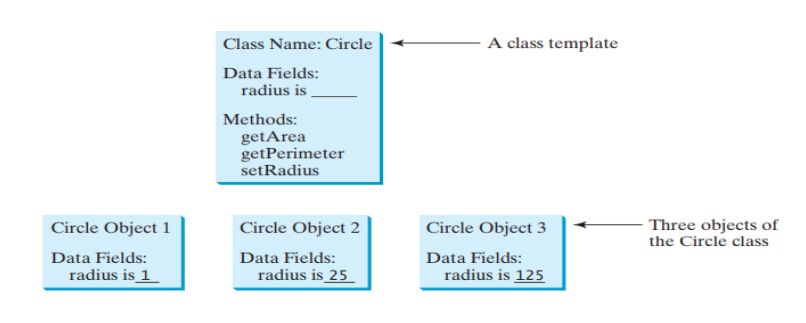
Implementation with Example – Creating Student Class
Let’s demonstrate how to create Class in Java with an example. Here is a Student class:
package net.javaguides.corejava.oops;
import java.lang.reflect.Constructor;
import java.lang.reflect.InvocationTargetException;
public class Student {
private String name = "Ramesh";
private String college = "ABC";
public Student() {
super();
}
public Student(String name, String college) {
super();
this.name = name;
this.college = college;
}
public String getName() {
return name;
}
public void setName(String name) {
this.name = name;
}
public String getCollege() {
return college;
}
public void setCollege(String college) {
this.college = college;
}
}3. Abstraction
Abstraction means hiding lower-level details and exposing only the essential and relevant details to the users.
Real-world examples
1. The first example, let’s consider a Car, which abstracts the internal details and exposes to the driver only those details that are relevant to the interaction of the driver with the Car.

2. The second example, consider an ATM Machine; All are performing operations on the ATM machine like cash withdrawal, money transfer, retrieve mini-statement…etc. but we can’t know internal details about ATM.

Implementation with Example
Example - Employee, Contractor, and FullTimeEmployee Example
In this example, we create an abstract Employee class and which contains abstract calculateSalary() method. Let the subclasses extend Employee class and implement a calculateSalary() method.
Let’s create Contractor and FullTimeEmployee classes as we know that the salary structure for a contractor and full-time employees are different so let these classes to override and implement a calculateSalary() method.

Let’s write source code by looking into an above class diagram.
Step 1: Let’s first create the superclass Employee. Note the usage of abstract keyword in this class definition. This marks the class to be abstract, which means it can not be instantiated directly. We define a method called calculateSalary() as an abstract method. This way you leave the implementation of this method to the inheritors of the Employee class.
public abstract class Employee {
private String name;
private int paymentPerHour;
public Employee(String name, int paymentPerHour) {
this.name = name;
this.paymentPerHour = paymentPerHour;
}
public abstract int calculateSalary();
public String getName() {
return name;
}
public void setName(String name) {
this.name = name;
}
public int getPaymentPerHour() {
return paymentPerHour;
}
public void setPaymentPerHour(int paymentPerHour) {
this.paymentPerHour = paymentPerHour;
}
}Step 2: The Contractor class inherits all properties from its parent abstract Employee class but have to provide its own implementation to calculateSalary() method. In this case, we multiply the value of payment per hour with given working hours.
public class Contractor extends Employee {
private int workingHours;
public Contractor(String name, int paymentPerHour, int workingHours) {
super(name, paymentPerHour);
this.workingHours = workingHours;
}
@Override
public int calculateSalary() {
return getPaymentPerHour() * workingHours;
}
}Step 3: The FullTimeEmployee also has its own implementation of calculateSalary() method. In this case, we just multiply by a constant value of 8 hours.
public class FullTimeEmployee extends Employee {
public FullTimeEmployee(String name, int paymentPerHour) {
super(name, paymentPerHour);
}
@Override
public int calculateSalary() {
return getPaymentPerHour() * 8;
}
}Step 4: Let’s create a AbstractionDemo class to test implementation of Abstraction with below code:
public class AbstractionDemo {
public static void main(String[] args) {
Employee contractor = new Contractor("contractor", 10, 10);
Employee fullTimeEmployee = new FullTimeEmployee("full time employee", 8);
System.out.println(contractor.calculateSalary());
System.out.println(fullTimeEmployee.calculateSalary());
}
}4. Encapsulation
Encapsulation is a process of wrapping of data and methods in a single unit is called encapsulation. In OOP, data and methods operating on that data are combined together to form a single unit, which is referred to as a Class.
Real-world examples
1. Capsule, it is wrapped with different medicines. In a capsule, all medicine is encapsulated inside a capsule.

2. A Java class is an example of encapsulation. Java bean is the fully encapsulated class because all the data members are private here.
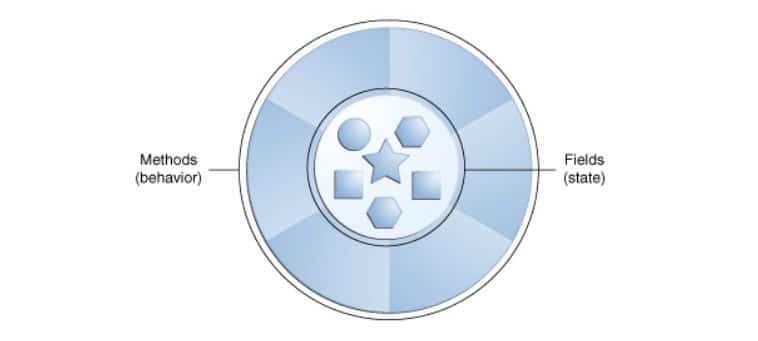
Implementation with Example
Consider below Person class diagram, the id and name parameters should not be accessed directly outside Person class – achieved by private declaration.
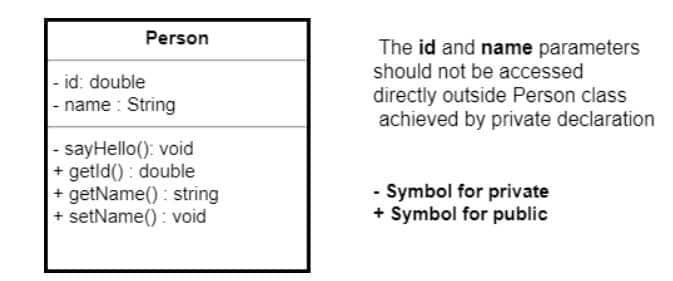
Let’s create a Person class to demonstrate the use of encapsulation in Java.
Step 1: Create a Person class.
public class Person {
private double id;
private String name;
public Person() {
// Only Person class can access and assign
id = Math.random();
sayHello();
}
// This method is protected for giving access within Person class only
private void sayHello() {
System.out.println("Hello - " + getId());
}
public double getId() {
return id;
}
public String getName() {
return name;
}
public void setName(String name) {
this.name = name;
}
}Step 2: Let’s test the Encapsulation via a main() method.
public class EncapsulationDemostration {
public static void main(String[] args) {
Person p1 = new Person();
p1.setName("Ramesh");
/*
* Note: As id and name are encapsulated in Person class, those cannot be
accessed
* directly here. Also there is no way to assign id in this
* class. Try to uncomment below code and you would find compile time
error.
*/
// p1.id = "123";
// p1.name = "this will give compile time error";
// p1.sayHello(); // You can't access this method, as it is private to
Person
System.out.println("Person 1 - " + p1.getId() + " : " + p1.getName());
}
}Difference between Abstraction and Encapsulation
Abstraction and Encapsulation in Java are two important Object-oriented programming concept and they are completely different to each other.
- Encapsulation is a process of binding or wrapping the data and the codes that operate on the data into a single entity. This keeps the data safe from outside interface and misuse.
- Abstraction is the concept of hiding irrelevant details. In other words, make the complex system simple by hiding the unnecessary detail from the user.
- Abstraction is implemented in Java using interface and abstract class while Encapsulation is implemented using private, package private and protected access modifiers.
- Abstraction solves the problem in the design level. Whereas Encapsulation solves the problem in the implementation level.
5. Inheritance
The Inheritance is a process of obtaining the data members and methods from one class to another class, plus can have its own is known as inheritance. It is one of the fundamental features of object-oriented programming.
Inheritance – IS-A relationship between a superclass and its subclasses.
Super Class: The class whose features are inherited is known as a superclass (or a base class or a parent class).
Sub Class: The class that inherits the other class is known as a subclass(or a derived class, extended class, or child class). The subclass can add its own fields and methods in addition to the superclass fields and methods.
Real-world example
1. The real-life example of inheritance is child and parents, all the properties of a father are inherited by his son.

2. In the Java library, you can see extensive use of inheritance. Below figure shows a partial inheritance hierarchy from a java.lang library. The Number class abstracts various numerical (reference) types such as Byte, Integer, Float, Double, Short, and BigDecimal.

Implementation with Example
Example 1: Let’s understand inheritance by example.
Dog class is inheriting behavior and properties of Animal class and can have its own too.
/**
* Test class for inheritance behavior - Dog class is inheriting behavior
* and properties of Animal class and can have its own too.
*
*
*/
public class Inheritance {
public static void main(String[] args) {
Animal dog = new Dog();
dog.setId(123); // inherited from super class
dog.sound(); // overrided behavior of sub class
}
}
/**
* This is parent (also called as super or base) class Animal
*
*/
class Animal {
int id;
public int getId() {
return id;
}
public void setId(int id) {
this.id = id;
}
public void sound() {
System.out.println("By default it is mute");
}
}
/**
* This is subclass (also called as derived or child or extended) Dog which is
extending Animal
*
*/
class Dog extends Animal {
// Own behavior
private void bark() {
System.out.println("Dog '" + getId() + "' is barking");
}
// Overriding super class behavior
@Override
public void sound() {
bark();
}
}The keyword used for inheritance is extends.
Syntax :
class derived-class extends base-class
{
//methods and fields
}Example 2: In this example, the Programmer is the subclass and Employee is the superclass. The relationship between the two classes is the Programmer IS-A Employee. It means that Programmer is a type of Employee.
class Employee{
float salary=40000;
}
class Programmer extends Employee{
int bonus=10000;
public static void main(String args[]){
Programmer p=new Programmer();
System.out.println("Programmer salary is:"+p.salary);
System.out.println("Bonus of Programmer is:"+p.bonus);
}
}Types of Inheritance in Java
Below are the different types of inheritance which are supported by Java.
1. Single Inheritance
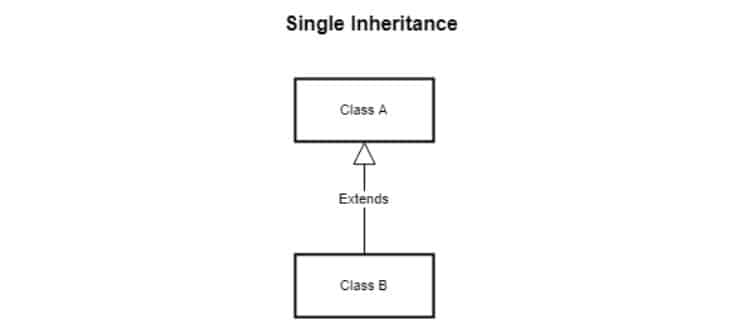
In single inheritance, subclasses inherit the features of one superclass. In the image below, class A serves as a base class for the derived class B.
2. Multilevel Inheritance
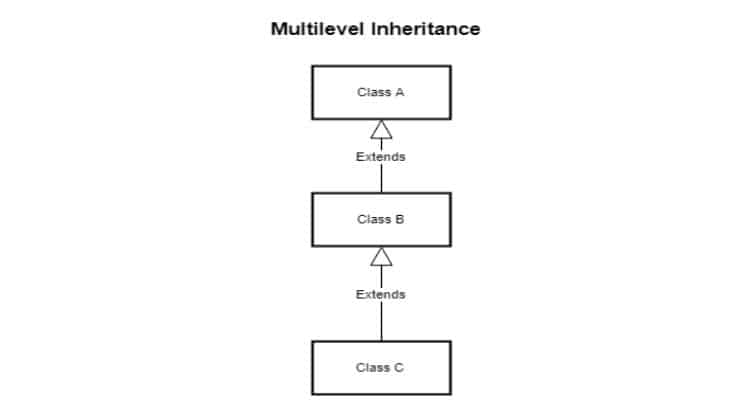
In Multilevel Inheritance, a derived class will be inheriting a base class and as well as the derived class also act as the base class to other class. In below image, class A serves as a base class for the derived class B, which in turn serves as a base class for the derived class C. In Java, a class cannot directly access the grand parent’s members.
3. Hierarchical Inheritance

In Hierarchical Inheritance, one class serves as a superclass (base class) for more than one subclass. In below image, class A serves as a base class for the derived class B and class C.
4. Multiple Inheritance (Through Interfaces)

In Multiple inheritances, one class can have more than one superclass and inherit features from all parent classes. Please note that Java does not support multiple inheritances with classes. In Java, we can achieve multiple inheritances only through Interfaces. In the image below, Class C is derived from class A and class B.
5. Hybrid Inheritance (Through Interfaces)
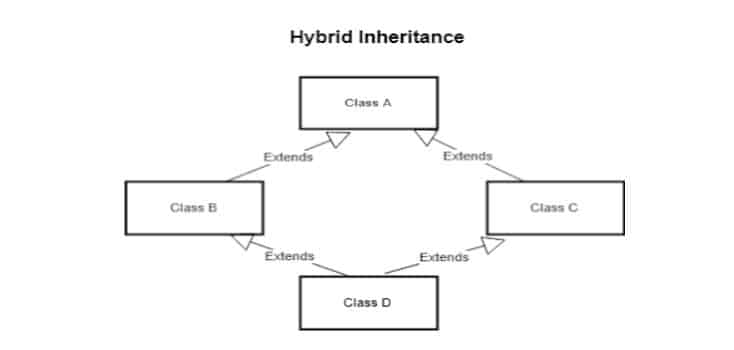
It is a mix of two or more of the above types of inheritance. Since java doesn’t support multiple inheritances with classes, the hybrid inheritance is also not possible with classes. In java, we can achieve hybrid inheritance only through Interfaces.
Why multiple inheritance is not supported in java?
To reduce the complexity and simplify the language, multiple inheritance is not supported in java. Consider a scenario where A, B, and C are three classes. The C class inherits A and B classes. If A and B classes have the same method and you call it from child class object, there will be ambiguity to call a method of A or B class.
Since compile-time errors are better than runtime errors, java renders compile-time error if you inherit 2 classes. So whether you have the same method or different, there will be compile time error now.
class A{
void msg(){System.out.println("Hello");}
}
class B{
void msg(){System.out.println("Welcome");}
}
class C extends A,B{//suppose if it were
Public Static void main(String args[]){
C obj=new C();
obj.msg();//Now which msg() method would be invoked?
}
}6. Polymorphism
The process of representing one form in multiple forms is known as Polymorphism.
Different definitions of Polymorphism are:
- Polymorphism let us perform a single action in different ways.
- Polymorphism allows you to define one interface and have multiple implementations
- We can create functions or reference variables which behaves differently in a different programmatic context.
- Polymorphism means many forms.
A real-world example of polymorphism
Suppose if you are in a classroom that time you behave like a student, when you are in the market at that time you behave like a customer, when you at your home at that time you behave like a son or daughter, Here one person present in different-different behaviors.

Implementation with Example
Example: Payment Processing Example
In this Payment Processing Example, applying runtime polymorphism and it can have many forms at runtime. Refer below source code the single payment “p” instance can be used to pay by cash and credit card, payment p instance takes many forms here.
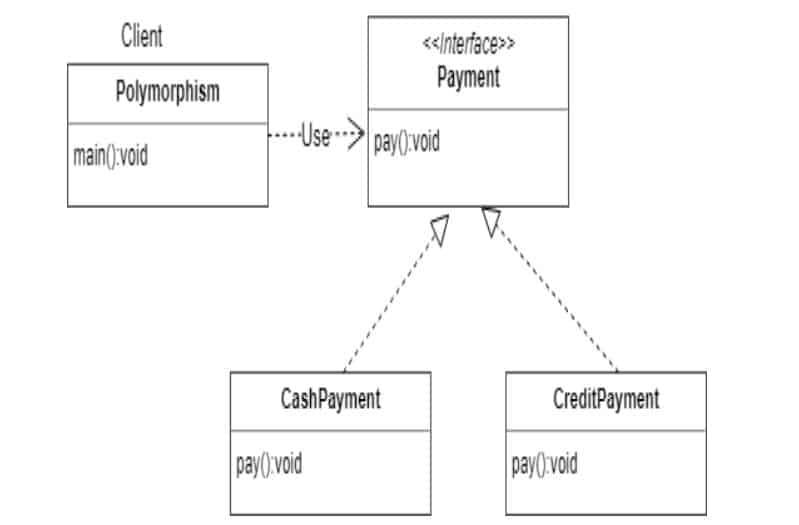
Let’s start coding by looking into above class diagram.
- Create Payment interface
- Create CashPayment class which implements Payment interface
- Create CreditPayment class which implements Payment interface
- Let’s create a Polymorphism class with main() method for testing.
Types of Polymorphism in Java
1. Compile time polymorphism or method overloading or static banding
2. Runtime polymorphism or method overriding or dynamic binding
When a type of the object is determined at a compiled time(by the compiler), it is known as static binding. When a type of the object is determined at run-time, it is known as dynamic binding.
1. Compile time Polymorphism
If the class contains two or more methods having the same name and different arguments then it is method overloading. The compiler will resolve the call to a correct method depending on the actual number and/or types of the passed parameters The advantage of method overloading is to increases the readability of the program.
Method Overloading: changing no. of arguments
In this example, we have created two methods, first, add() method performs the addition of two numbers and a second add method performs addition of three numbers. In this example, we are creating static methods so that we don’t need to create an instance for calling methods.
class Adder {
static int add(int a, int b) {
return a + b;
}
static int add(int a, int b, int c) {
return a + b + c;
}
}
class TestOverloading1 {
public static void main(String[] args) {
System.out.println(Adder.add(11, 11));
System.out.println(Adder.add(11, 11, 11));
}
}In this example, we have created two methods that differ in data type. The first add method receives two integer arguments and second add method receives two double arguments.
class Adder {
static int add(int a, int b) {
return a + b;
}
static double add(double a, double b) {
return a + b;
}
}
class TestOverloading2 {
public static void main(String[] args) {
System.out.println(Adder.add(11, 11));
System.out.println(Adder.add(12.3, 12.6));
}
}2.Runtime Polymorphism
Runtime polymorphism is a process in which a call to an overridden method is resolved at runtime rather than compile-time. In this process, an overridden method is called through the reference variable of a superclass. The determination of the method to be called is based on the object being referred to by the reference variable. Let’s first understand the upcasting before Runtime Polymorphism.

When reference variable of Parent class refers to the object of Child class, it is known as upcasting.
For example:
class A {}
class B extends A {}
class Demo {
public static void main(String[] args) {
A a = new B(); //upcasting
}
}Java Runtime Polymorphism Example: Shape Example

class Shape {
void draw() {
System.out.println("drawing...");
}
}
class Rectangle extends Shape {
void draw() {
System.out.println("drawing rectangle...");
}
}
class Circle extends Shape {
void draw() {
System.out.println("drawing circle...");
}
}
class Triangle extends Shape {
void draw() {
System.out.println("drawing triangle...");
}
}
class TestPolymorphism2 {
public static void main(String args[]) {
Shape s;
s = new Rectangle();
s.draw();
s = new Circle();
s.draw();
s = new Triangle();
s.draw();
}
}Output:
drawing rectangle...
drawing circle...
drawing triangle...Java Runtime Polymorphism with Data Member
The method is overridden not applicable data members, so runtime polymorphism can’t be achieved by data members. In the example given below, both the classes have a data member speedlimit, we are accessing the data member by the reference variable of Parent class which refers to the subclass object. Since we are accessing the data member which is not overridden, hence it will access the data member of Parent
class always.
class Bike {
int speedlimit = 90;
}
class Honda extends Bike {
int speedlimit = 150;
public static void main(String args[]) {
Bike obj = new Honda();
System.out.println(obj.speedlimit); //90
}
}Output:
90Let’s try the below scenario: Here the BabyDog is not overriding the eat() method, so eat() method of Dog class is invoked. Note that if we are not using @Override annotation in this example.
class Animal {
void eat() {
System.out.println("animal is eating...");
}
}
class Dog extends Animal {
void eat() {
System.out.println("dog is eating...");
}
}
class BabyDog1 extends Dog {
public static void main(String args[]) {
Animal a = new BabyDog1();
a.eat();
}
}Output:
dog is eating...Polymorphism – Method Overloading vs Method Overriding
The differences between Method Overloading and Method Overriding in Java are as follows:
| Method Overloading | Method Overriding |
|---|---|
| Method overloading is a compile-time polymorphism. | Method overriding is a run-time polymorphism. |
| Method overloading helps to increase the readability of the program. | Method overriding is used to grant the specific implementation of the method which is already provided by its parent class or superclass. |
| It occurs within the class. | It is performed in two classes with inheritance relationships. |
| Method overloading may or may not require inheritance. | Method overriding always needs inheritance. |
| In method overloading, methods must have the same name and different signatures. | In method overriding, methods must have the same name and same signature. |
| In method overloading, the return type can or can not be the same, but we just have to change the parameter. | In method overriding, the return type must be the same or co-variant. |
| Static binding is being used for overloaded methods. | Dynamic binding is being used for overriding methods. |
| Poor Performance due to compile time polymorphism. | It gives better performance. The reason behind this is that the binding of overridden methods is being done at runtime. |
| Private and final methods can be overloaded. | Private and final methods can’t be overridden. |
| The argument list should be different while doing method overloading. | The argument list should be the same in method overriding. |
Harnessing these principles in tandem empowers developers to craft scalable, maintainable, and flexible software solutions. 💻✨ What’s your go-to OOP principle? Let’s share insights! 👩💻👨💻 OOP hashtagCodingPrinciplesSoftwareDevelopment. Also Check out some Important Interview Questions

